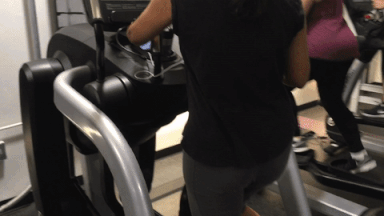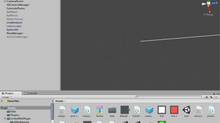PComp | Week 3 | Observing the Elliptical
Elliptical is a machine that looks like this:

Ellipticals are used for cardio exercise in gyms or fitness centre. Typically the duration of usage is between 10-30 mins long (NYU gym has posters everywhere stating that the maximum duration is 25 mins).
These machines are typically put in a row (or rows), so you can usually see other people operating and using the machine before you try them (and sometimes you get intimidated by how hardcore and sweaty they look).
Usage assumptions
Exercise functions
Use the machine to run (feet pushing on the pedal)
Adjust the speed (interface on screen)
Adjust the resistance (interface on screen)
Monitor heart rate (by touching the metal plate on the handles)
Monitor running distance, speed, & duration
Entertainment functions
Watch TV
Listen to music
Analysis on the design
Curviness
The elliptical, other than suggested by its name, has a lot of curves in its design. The wheel-looking thing that is connected to the pedal, the way the handles curve, etc.
I think it serves two functions: safety, and non verbal cues. Safety because you don't want to bump into hard edges and get cut, and non verbal cues of saying that this machine is friendly to girls & ladies too (in contrast to boxy weigh machines).
Material
Even before I step onto the pedals or grip the handles, I knew that I won't slip while using the elliptical. This is because of the affordances of the rubbery coating the machine has.
Real Usage

Use the machine to run
Users don't have to turn on the machine, they can immediately start moving their legs and get speed reading on the screen. However, the direction of running (forward / backward) was not as intuitive as the treadmill.

She got it backward for 1 second
There are 2 sets of handles, and the higher ones you can push to help you run, while the lower ones are typically used if the user needs to stabilise him/herself or doesn't want to use hands to push. It is quite intuitive to the user as the higher handles move along with the pedals while the lower ones stay still.
Adjust speed
There is no such thing; you just start running.
Adjust resistance
This can be done in two ways. One is by pressing a button on the screen, the second one is by pressing the physical button placed on the right lower handle.
Option one, however, is more difficult to do because the user has to put effort in maintaining balance while running and reaching out to screen, or the user has to slow down. Users usually use the buttons on the low handle more.
The feedback is immediate and user can feel that it gets harder to run almost instantly.
Monitor heart rate
The metal plate is positioned right where the hand would grip the handles, and the contrast between the sheen against dark rubbery material on the handles also serves as a visual clue as to where your hands should be.
The feedback is not immediate as the machine needs a few seconds to record the heart rate. Also, this is not a piece on info that user monitors all the time. Most of the time it is just there because his/her hands are on the plate.
Monitor running distance, speed, & duration
In my opinion this is the easiest interaction. The transaction of checking these exercise measures were effortless as user just has to perform the core function the machine is built for (i.e. running) and the indicators on the screen are immediately responsive.
Skipped/Unused Functions
More complicated exercise guide (e.g. telling the user when to slow down, speed up, do by distance or by duration) | The machines are in a public gym, and as such users do not want to hog the machine figuring out the functions or pressing the screens for too long.
"Save" your exercises function | No one knows how to do it.
Watch TV | It's harder to watch when your body moves up and down.
Listen to music | Users just use their own phones because it is more convenient.
However, it is also to note that the user can just ignore this and just start running right away. Auxiliary functions are kept auxiliary.
All and all I think elliptical is a great interactive piece of technology. It serves the core function of facilitating running / cardio exercises well. What users need to essentially do is to start running and the machine constrains users movement according to the natural way of running, and maps the act of running with running metrics displayed instantly on the screen.
The material and design also gives subconscious cues to the user that the machine is safe to use and that he or she won't slip.
However, when it comes to more complicated functions like exercise planning and watching TV, the elliptical gets more awkward, as pressing screen while running is not exactly ideal. Often keeping it simple and truthful to its core function are what make a piece of technology economical, practical, and user-friendly.












